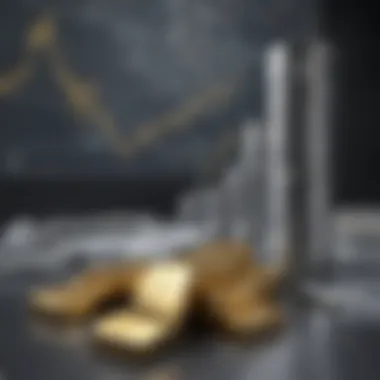Understanding Gold and Silver Valuation and Trends


Intro
Gold and silver have always held a unique place in human society. Their allure stretches back thousands of years, captivating the imagination of emperors, traders, and everyday folk alike. Today, they're more than just shiny pieces of metal; they are prized investments and a hedge against economic uncertainty. As we delve into the intricacies of their value, we'll explore what makes them tick in the modern marketplace.
To truly understand these precious metals, one must look beyond the glitter and dive into what they represent in financial terms. It’s not merely about their physical beauty or historic significance; it involves scrutinizing market dynamics, economic indicators, and how each element contributes to the price fluctuations observed over time. In this exploration, we aim to provide you with a nuanced perspective on gold and silver, equipping investors and financial advisors with the knowledge needed for informed decision-making.
Investment Terminology Breakdown
Key Terms Explained
When talking about investments, particularly in precious metals, a solid grasp of relevant terminology is crucial. Understanding the language of finance can save you from pitfalls down the line. Here are a few key terms:
- Spot Price: This refers to the current market price at which gold or silver can be bought or sold for immediate delivery. Think of it as the real-time value reflecting supply and demand.
- Futures Contract: This is an agreement to buy or sell a specific quantity of gold or silver at a predetermined price at a future date. It’s an avenue for speculation, allowing investors to bet on future price movements.
- Bullion: This term describes precious metals in bulk form, usually refined and stamped, which investors buy as a store of value, as opposed to coins or jewelry.
- Arbitrage: A strategy where investors exploit price discrepancies between markets, selling gold or silver in one market while buying in another.
Understanding these terms can significantly enhance your ability to navigate the complexities of precious metal investments.
Common Misconceptions in Investing
Investing in gold and silver is often shrouded in myths that can mislead newcomers. Here are some common misconceptions:
- Gold is always a safe investment.
While gold is often heralded as a safe haven, its price can fluctuate based on market conditions, geopolitical tensions, and economic indicators. It’s essential to analyze these factors before investing. - All silver is the same.
Fact is, differing purities and forms of silver affect its market value. For instance, pure silver bullion is valued differently than silver coins or industrial silver. - Investing in precious metals guarantees profit.
Like any investment, gold and silver prices can drop. A nuanced understanding of market trends and historical performance helps mitigate risks.
"Investing without knowledge is like sailing a ship without knowing how to navigate."
In acknowledging these misconceptions, you can position yourself more advantageously in the market. This already sets the foundation for deeper analysis, helping you avoid common pitfalls that many investors face when considering gold and silver.
As we proceed through this article, we will delve into the detailed examination of their historical context, economic factors, and what they mean for today's portfolio strategies. Stay tuned for insights that can empower your investment journey.
The Historical Context of Gold and Silver
Understanding the historical context of gold and silver is essential for grasping their significance as commodities and investment vehicles. Through the ages, these precious metals have been intertwined with human civilization, influencing trade, culture, and economics. This narrative not only offers insight into their intrinsic value but also reveals how historical events have shaped their current market perception.
Origins and Ancient Uses
Gold and silver have ancient roots that stretch back thousands of years. Their journey starts around 5000 BCE, where archeologists have uncovered evidence of their usage in the form of jewelry and artifacts. This artistry indicates not just value but a form of cultural expression. Ancients viewed these metals as gifts from the gods, assigning them positions of honor and reverence.
Beyond mere decoration, gold and silver found practical applications early on. For example, in ancient Egypt, gold wasn’t just a symbol of wealth; it was essential in burial rites, emphasizing the belief in an afterlife. The famous pharaoh Tutankhamun’s tomb, brimming with gold artifacts, underlines this connection between metal and spirituality. In Mesopotamia, similar tales unfold with silver serving as both a form of currency and a medium of exchange.
Gold and Silver in Trade
As civilizations flourished, so did the need for trade. Gold and silver became pivotal in establishing trade networks across continents. Ancient merchants traded gold for spices, textiles, and other goods. The invention of coinage around 600 BCE revolutionized commerce, making transactions smoother and more efficient. Coins made from these precious metals were widely trusted, given their tangible value and authenticity.
The journey of these metals through trade routes is rich with tales of discovery and interaction. The famous Silk Road, for instance, was not just a pathway for silk and other goods. It also facilitated the exchange of ideas, cultures, and of course, precious metals. The history is filled with instances where traders transported gold and silver across mountains and deserts, creating an early global economy.
The Role of Precious Metals in Currency
The use of gold and silver in currency is a story of their enduring value. In the early ages, it wasn't uncommon for these metals to represent a standard of wealth. By establishing a currency based on gold or silver, societies were able to unify economic systems—no longer did wealth get measured in livestock or grains, but by fixed monetary standards.
This concept culminated in the Gold Standard of the 19th century, where countries pegged their currency to a specific amount of gold, ensuring stability and trust in economic exchange. But as the world evolved, so did the monetary systems, transitioning away from the gold standard.
In modern times, while fiat currency reigns, the shadows of gold and silver persist, often regarded as "safe havens" during economic uncertainty. Investors tend to flock to these precious metals as a safeguard against inflation and currency devaluation.
"Gold and silver are not just assets; they carry the weight of history and the promise of stability in turbulent times."
In summary, the historical context of gold and silver is rich and multifaceted. Understanding their origins, their critical role in trade, and their evolution into forms of currency is imperative for anyone looking to navigate today’s investment landscape. The legacy of these precious metals is embedded in our collective past and continues to shape our economic future.
Economic Analysis of Currency and Commodities
In navigating the complex world of investments, understanding how currency and commodities interplay forms the bedrock of a wise investment strategy. Gold and silver serve as not just commodities but also intrinsic parts of this economic puzzle, and grasping their behavior in the face of various economic cycles gives investors a competitive edge. The economic analysis surrounding these precious metals takes into account inflation and deflation cycles, correlations with other assets, and global economic indicators. Each of these elements shines a light on how gold and silver maintain their relevance in the ever-shifting market landscape.
Inflation and Deflation Cycles
To wrap our heads around the value of gold and silver, one must first comprehend inflation and deflation cycles, which are critical for predicting commodity prices. When inflation kicks in, currencies tend to lose their purchasing power. Investors often scramble for a safe haven, turning to gold and silver, which historically retain value during such turbulent times.


For example, during the 1970s inflationary surge in the United States, gold prices soared, reaching an all-time high. With many folks seeing their dollars dwindle in worth, precious metals became the go-to refuge, and their prices reflected this trend. Conversely, in a deflationary environment, the value of cash rises, while commodities may see a decline, leading to a more complicated landscape. Investors have to gauge these cycles carefully to identify the right entry points for investing in precious metals.
Correlation with Other Assets
Another layer of analysis centers around the correlation of gold and silver with other assets. Understanding these relationships provides insight into managing portfolios effectively. For instance, gold often moves inversely to equities; when stock prices tumble, gold often picks up steam, acting as a hedge against market downturns.
Similarly, the relationship between gold, silver, and bonds can offer valuable cues. Rising bond yields may lead investors to favor yield-generating assets over non-interest-bearing ones like gold and silver. This is not a hard and fast rule, though, as the shifts in investor sentiment can create unexpected correlations.
Here’s a quick breakdown:
- Gold and Silver vs. Stocks: Generally, they have an inverse relationship.
- Interest Rates vs. Precious Metals: Higher interest rates can depress metal prices.
Understanding these correlations and adjusting investment strategies accordingly can significantly impact portfolio performance.
Global Economic Indicators
Broadening the scope, global economic indicators play a fundamental role in determining the worth and trajectory of gold and silver. Factors like GDP growth rates, employment figures, and monetary policy decisions from central banks can sway investor confidence. When economic conditions appear shaky, the demand for precious metals typically increases.
For example, central banks holding gold reserves often signal a vote of confidence in the metal’s enduring reliability. On the other hand, strong economic indicators can lead to reduced demand, as investors may shift focus to equities or bonds.
Key indicators to keep an eye on include:
- Consumer Price Index (CPI): A rising CPI usually points to inflation, sparking interest in gold.
- Balance of Trade Figures: A weak trade balance may weaken a nation’s currency and push citizens toward gold and silver.
- Interest Rate Decisions: As mentioned earlier, these can directly influence metal prices.
Navigating this economic terrain requires a keen observation of these indicators to project future movements in precious metal values. By integrating inflation expectations, correlations with other financial products, and global economic standing into investment strategies, investors can position themselves more advantageously in the dynamic world of gold and silver.
Current Market Dynamics
Understanding the current market dynamics surrounding gold and silver is crucial for both investors and analysts in today’s financial landscape. These precious metals do not exist in a vacuum; their values are shaped by myriad factors including supply and demand, geopolitical events, and investment trends.
In essence, the dynamics of the market reveal not just the current worth of these metals but also their role within the broader economic context. Recent years have shown that gold and silver often serve as safe havens during turbulent times, making them an integral part of risk management strategies. The understanding of how these factors interplay can greatly enhance investment decision-making.
Market Demand and Supply Conditions
The interplay between demand and supply is fundamental to the valuation of gold and silver. On one hand, there’s the physical demand that comes from jewelry making, industrial use, and technological applications, which includes everything from solar panels to electronics. On the other hand, supply conditions are dictated by mining production and recycling. When mines are operational at full throttle yet demand increases—perhaps due to economic uncertainty—the prices tend to rise.
In recent times, global supply chain disruptions resulting from pandemic-related challenges have significantly influenced production capabilities. This has seen many investors closely monitoring production outputs from major mining countries such as China and Australia.
- Physical Demand: Jewelry and technology sectors keenly influence market trends.
- Investor Sentiment: As economic forecasts fluctuate, so does demand from investors.
- Supply Adjustments: Mining output and recycling efforts directly link back to market prices.
Geopolitical Influences
Geopolitical factors present another layer of complexity in understanding gold and silver’s market dynamics. Movement in prices often reacts sharply to international events. For example, tensions in the Middle East can lead investors to flock towards gold as a refuge, driving prices upward. Furthermore, central banks buying or selling reserves also play a pivotal role in shaping market confidence.
"Gold is a great hedge against geopolitical turmoil, a trend all too common in today’s intricate world stage."
- Sanctions and Trade Wars: These can create uncertainties about currency stability, making precious metals appealing as a safe-haven investment.
- Central Bank Policies: The behavior of these institutions has direct implications for market volatility.
- Global Crises: Events such as pandemics or wars often lead to increased investment in gold and silver.
Investment Trends Affecting Prices
Understanding investment trends is vital for gauging the future prices of gold and silver. In recent years, there has been a notable uptick in retail investments through various channels including ETFs and mining stocks. Millennials and Gen Z investors are particularly gravitating towards these assets, driven by fears of inflation and economic instability.
Additionally, institutional investors have also been increasing their allocations towards these metals, signaling a robust and sustained demand. The strategies they employ often include diversifying portfolios with gold and silver to mitigate risks associated with traditional equity markets.
- Exchange-Traded Funds (ETFs): They have simplified access for average investors, leading to a surge in retail demand.
- Rising Awareness: Educational campaigns and web-based platforms have resulted in more informed investment choices.
- Societal Shifts: Environmentally-conscious mining practices and ethical investing give newer generations reasons to invest in these assets.
Each factor surrounding current market dynamics provides crucial insights for those looking to invest in gold and silver. Recognizing the importance of demand-supply relations, geopolitical considerations, and evolving investment trends not only helps in making informed decisions but also sets a foundation for anticipating future movements in these precious metals' valuations.
The Role of Gold in Investment Portfolios
Gold has long been recognized not just as a flashy ornament or a luxurious investment but as a vital element in the art of portfolio management. It’s often viewed as a safe haven during times of economic turmoil, a hedge against inflation, and a tool to achieve diversification. Simply put, including gold in an investment strategy can offer a cushion against market volatility.
Diversification is a key consideration when constructing any investment portfolio. The idea is to spread around assets to reduce risk. Gold, with its low correlation to other assets like stocks and bonds, can help smooth out returns during turbulent times. When stocks take a nosedive, gold often shines brightly, absorbing some of the shocks of a falling market. This interplay plays a significant role in stabilizing the overall performance of a portfolio.
Furthermore, understanding how gold acts as a counterbalance in economic scenarios is critical. During inflation or geopolitical unrest, investors gravitate towards gold, pushing its price up while other investments may falter. So, in essence, having this precious metal in one's portfolio isn't just about its sudden price spikes, but rather about creating a fortress that withstands the tests of time and circumstances.


Diversification Benefits
Gold's intrinsic value has been recognized for centuries. As its price behaves differently than equities and bonds, it serves as a stabilizing force in a diverse portfolio. Consider the following points regarding diversification:
- Negative Correlation: When traditional markets plummet, gold tends to hold or increase its value, offering protective benefits.
- Historical Performance: Over decades, gold has shown resilience, particularly during significant financial crises, further establishing its credentials as a dependable asset.
- Portfolio Balance: Allocating a modest portion, often cited at around 5-10% of an investment portfolio, can dramatically lessen risk and enhance overall performance.
This balance can often prove essential for investors seeking to maintain steadiness through various economic cycles. The concept of not putting all one’s eggs in one basket takes center stage here.
Risk Management Strategies
In a world rife with uncertainties, managing risk becomes paramount for investors. Here’s where gold makes its entrance as a potential shield:
- Market Volatility Protection: In periods of heighted volatility in stock markets, investors often shift their funds to gold, anticipating a flight to safety. This behavior reiterates gold’s role as a reliable hedge against unpredictable downturns.
- Inflation Hedge: When the dollar weakens and inflation rises, gold typically counters by maintaining or increasing its value. For investors wary of printed currency losing purchasing power, gold stands as a line of defense.
- Geopolitical Safeguard: Gold acts as a reliable asset during geopolitical tensions or crises. Historical events show that gold prices tend to surge in such situations, making it an appealing choice for those looking to shield their portfolios from unexpected global events.
“Gold is a safe haven; it’s a reliable form of wealth, trusted through time.”
Long-Term vs. Short-Term Investment
The intentions behind investing in gold can diverge significantly based on personal financial strategies. Some view it as a long-term store of value, while others might engage in shorter-term trades:
- Long-Term Investment: For those embracing a long-term view, gold can serve as a fundamental touchstone, symbolizing preservation of wealth across generations. Historically, gold maintains purchasing power over decades, making it attractive for retirement portfolios or legacy planning.
- Short-Term Opportunities: Savvy traders may capitalize on fluctuations in gold prices, using technical analyses to buy low and sell high. Such strategies require keen awareness of market trends and fluctuations, which can be tricky for the casual investor.
Whether leveraging gold for its long-term stability or plunging into short-term trades, the decision hinges on personal financial goals, risk tolerance, and market acumen. Understanding these dynamics is essential for successfully navigating the waters of gold investment.
The Role of Silver in Investment Portfolios
Silver has always occupied a distinctive position in the realm of precious metals. While gold often steals the spotlight in investment discussions, silver presents unique attributes that make it an essential contender in portfolio diversification. Investors who take the time to understand silver's role can harness its potential effectively. This section delves into the crucial aspects of silver as an investment tool, emphasizing its multiple uses and the dynamics that shape its market.
Different Uses and Demand Drivers
Historically, silver's usefulness extends far beyond just being a shiny metal used in jewelry. Today, its versatility plays a vital role in various sectors, which can have a significant impact on its value. Notably, silver is a key component in electronics, playing a crucial role in devices like smartphones and solar panels.
Key sectors driving silver demand include:
- Industrial applications: About 50% of silver is consumed in industrial processes. Its superior conductivity and thermal properties make it ideal for electronic components and photovoltaic systems.
- Jewelry and silverware: Despite the rise of synthetic materials, silver remains a fine choice for both aesthetic and practical reasons.
- Investments: Physical silver, in the form of coins and bars, is a popular choice for investors aiming to hedge against economic uncertainties.
These demand drivers showcase silver's multifaceted role and hint towards its potential price stability in changing market conditions. As industries evolve, so too does the demand for silver, reinforcing its relevance as a strategic asset.
Comparative Value to Gold
A common question that arises among investors is how silver stands up against its more illustrious counterpart, gold. While gold is often viewed as the ultimate store of value, silver provides an intriguing alternative that can serve as a creative solution in an investment strategy.
Several differences highlight silver's position:
- Price Accessibility: The most glaring distinction lies in the price. Silver is significantly more affordable than gold, making it a more approachable option for novice investors or those looking to accumulate over time.
- Market Volatility: Historically, silver has shown greater price volatility compared to gold. This characteristic can be both a blessing and a curse; while it presents opportunities for traders, it requires caution from long-term investors.
- Economic Correlation: Silver tends to react differently to economic shifts. In instances of inflation, investors usually flock to gold, while silver's demand often surges in times of industrial growth, reflecting its dual role as both a commodity and a precious metal.
The comparative analysis showcases silver’s unique potential, allowing investors to balance risk and reward effectively within their portfolios.
Trends in Industrial Demand
In recent years, the landscape surrounding silver has experienced considerable changes due to burgeoning industries and shifting consumer behaviors. The increasing pace of technological advancement has fueled a spike in industrial demand, transforming how silver is perceived in investment circles.
Some notable trends include:
- Renewable Energy: The push for solar energy solutions has created a robust market for silver. Solar panels utilize silver in photovoltaic cells, and as countries prioritize green energy, the demand for silver is likely to flourish.
- Technology: As the tech sector continues to innovate—from smartphones to electric vehicles—silver's conductive properties make it indispensable, ensuring steady demand across various applications.
- Health Sector: Silver's antimicrobial properties have led to its usage in medical devices and treatments, further solidifying its importance as a material in healthcare products.
Understanding these trends can empower investors to anticipate market shifts, ensuring they take advantage of silver's evolving narrative. As demand drivers continue to change, it becomes imperative for investors to remain informed and nimble, positioning silver as a pillar of their investment profiles.
Investment Vehicles for Gold and Silver
When it comes to investing in gold and silver, understanding the different vehicles available is essential. The not only present unique opportunities for profit but also diverse methods to manage risk. These investment vehicles have different structures, liquidity, and potential for returns. By dissecting each option, investors can better align their strategies with their financial goals.
Physical Assets: Bars and Coins
Investing in physical gold and silver remains a traditional approach that many investors favor. Bars and coins can be considered tangible assets; they allow you to hold actual metal in your hand. This might provide a common perception of security that paper assets can lack.


- Types of Assets: Gold bars come in various sizes, often measured in ounces, with the one-ounce bar being quite popular. Coins, like the American Gold Eagle or Canadian Maple Leaf, are recognized worldwide and often carry a collectable premium over spot prices.
- Storage Considerations: Physical ownership does come with responsibilities. Investors must consider how to securely store their assets. Options include bank safety deposit boxes, home safes, or specialized storage facilities.
- Liquidity Factors: While physical gold and silver can be liquidated, the process may not be as straightforward or instantaneous as selling stocks. There may be waiting periods for valuations, especially when selling coins, which could fetch varying premiums.
The attraction to ownership of physical assets lies in the inherent value of gold and silver, their history as currency, and their ability to act as a hedge against inflation.
Exchange-Traded Funds (ETFs)
Exchange-Traded Funds provide another avenue for investing in precious metals without the hassles of physical storage or liquidity issues. These funds pool money from multiple investors to purchase gold or silver assets, and they trade on the major exchanges, just like stocks.
- Accessibility: Investors can buy and sell shares of an ETF throughout the trading day, providing flexibility that physical assets lack.
- Types Available: Funds such as the SPDR Gold Shares or iShares Silver Trust track the price of gold and silver respectively, backing their shares directly with physical metal retained in secure vaults.
- Expense Ratios: While these funds have management fees, they can be lower than the costs associated with storing and insuring physical metals.
Investing through ETFs can enhance market access and ease management, appealing to a broader range of investors, from novices to seasoned players.
Mining Stocks and Mutual Funds
Investors looking for exposure to gold and silver can also consider mining stocks and mutual funds focused on the sector. While riskier, these investment vehicles can potentially offer higher returns when prices climb.
- Mining Stocks: Directly investing in mining companies enables investors to tap into potential rewards linked to operational efficiencies or increases in extraction production. Be mindful though, as the success of these companies often hinges on factors beyond just metal prices, such as management decisions and operational risks.
- Mutual Funds: These funds combine many different mining stocks, providing diversification within the gold and silver sector. This can help mitigate individual stock risks, allowing investors to capture broader market trends.
- Market Sensitivity: Stocks linked to precious metals can be quite volatile, reacting not only to shifts in metal prices but also to overall market sentiment.
Utilizing mining stocks and mutual funds can establish a more aggressive investment strategy, appealing to those willing to embrace risk for potential higher returns.
Future Trends in Gold and Silver Investment
The landscape of investments is constantly shifting, and understanding future trends in gold and silver investment isn’t just beneficial; it's vital for anyone looking to safeguard their financial future. Whether you are a seasoned investor, a financial advisor, or someone dipping their toes into the world of precious metals, grasping the nuances of these trends provides invaluable insight into market dynamics. This section delves into the pressing factors influencing gold and silver investments, touching on technological advancements, environmental sustainability, and the possible price fluctuations that could arise.
Technological Innovations Affecting Mining and Production
As the world gears up for a greener future, technology is playing a pivotal role in reshaping how gold and silver are mined and produced. Innovations such as automated mining equipment and advanced data analytics are enhancing operational efficiency. For instance, using drones to survey mines can significantly reduce the time spent on manual inspections. Moreover, the adoption of more efficient extraction processes, like bioleaching, is becoming common in the industry. This method, which utilizes bacteria to extract metals from ore, minimizes environmental footprints and lowers costs.
Investors are increasingly aware that companies embracing these technologies may stand to benefit in the long run. They are likely to enjoy lower production costs and improved yields, making them more competitive. As tech continues to evolve, it could redefine profitability metrics in the sector.
Environmental Considerations and Sustainability
The conversation around environmental sustainability can no longer be brushed aside, especially in the realm of precious metals. Investors must consider how companies address their ecological footprints. As climate change continues to escalate as a concern, mining operations that fail to adopt sustainable practices are facing mounting scrutiny. Regulations are tightening, pushing companies to invest in cleaner technologies and greener practices.
For instance, firms that actively engage in reducing water usage or that commit to land reclamation programs post-mining may see enhanced reputations and, potentially, better stock performance. Investors looking to the future should recognize that sustainability isn’t just a buzzword; it's an essential aspect of corporate strategy that could dictate the success or failure of mining enterprises in the coming years.
Potential Price Fluctuations and Predictions
The unpredictable nature of markets can make investors jittery, especially regarding precious metals like gold and silver. Price fluctuations are driven by a myriad of factors including geopolitical rumors, economic indicators, and changes in technology and mining practices. For example, if inflation is on the rise, investors often flock to gold as a safe haven, thus pushing prices higher.
Furthermore, fluctuations in production costs due to technological advancements could also lead to changes in how the metals are priced. Retail and industrial demand can send prices on a roller coaster ride; if technology reduces production costs substantially, we might see a dip in prices before they stabilize.
Investment Tip: Keeping a pulse on global economic indicators will allow investors to anticipate potential price trends for gold and silver.
To summarize, understanding future trends in gold and silver investment entails more than just analyzing past performance; it demands an exploration of technological innovations, environmental sustainability, and macroeconomic factors that can influence pricing. Investing in these precious metals is not a one-size-fits-all strategy.
Seasoned investors, fresh faces, or financial analysts alike should be ever-vigilant, keeping abreast of developments in these areas to devise informed strategies that mirror the evolving market landscape.
End
In wrapping up our discussion on gold and silver, it becomes clear that understanding their value goes well beyond the surface-level price tag. These precious metals, with their rich histories and economic significance, offer not only traditional investment options but also serve as barometers of economic health and stability. When we dive deep into the dynamics surrounding gold and silver, we find several pivotal elements that can shape one’s investment decisions.
Summary of Key Insights
The analysis has showcased how gold behaviors differently compared to silver. For starters, gold tends to hold its value more consistently during economic downturns, making it a safe haven for investors looking to hedge against inflation or currency fluctuations. Interestingly, silver, often seen as a more volatile asset, is heavily influenced by industrial demand, which introduces unique investment considerations.
Here are some key insights to take away:
- Economic indicators: Gold often rises when economies falter, while silver can be driven by industrial demand successes.
- Risk Factors: The price of gold may be more stable, but silver offers opportunities for diversification and potential returns.
- Investment Vehicles: From bars and coins to ETFs and stocks in mining companies, investors have a smorgasbord of options at their disposal.
"Gold is a time-tested asset that has survived the test of time, while silver's industrial applications provide its own unique value proposition."
Evaluating Personal Investment Strategies
Reflecting on personal investment strategies requires a deliberate approach to balancing risk and reward. Investors ought to assess their own situations clearly and consider factors, such as the entirety of their portfolios and individual risk tolerances. Balancing gold and silver can lead to an enhanced investment strategy that meets both safety and growth metrics.
Some considerations for crafting a robust strategy include:
- Goal Setting: Understand your investment goals. Are you looking for security, growth, or a blend of both?
- Market Awareness: Stay informed on market conditions, such as geopolitical tensions and economic trends, which can directly impact gold and silver prices.
- Diversification: Avoid putting all your eggs in one basket. A mix of both gold and silver can smooth out volatility.
- Long-Term Perspective: While short-term trading can be tempting, maintaining a long-term viewpoint may provide better returns over time.
Assessing one’s position in relation to gold and silver can lead to more informed decisions. Investing in these precious metals is not just a play on prices; rather, it’s a strategic choice linked with broader economic narratives. Understanding these elements equips investors and financial advisors alike to navigate the complexities of these markets effectively.















